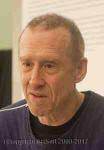William Forsyth
William Forsyth
Born: 1949
Biography:
William Forsythe is an American dancer and choreographer resident in Frankfurt am Main in Hessen. He is known internationally for his work with the Ballet Frankfurt (1984–2004) and The Forsythe Company (2005–2015). Recognized for the integration of ballet and visual arts, which displayed both abstraction and forceful theatricality, his vision of choreography as an organizational practice has inspired him to produce numerous installations, films, and web-based knowledge creation, incorporating the spoken word {and} experimental music.
William Forsythe was born in New York in 1949, but only started dancing seriously in his later teenage years in college. He followed his grandfather musically as he was a violin prodigy. Forsythe played bassoon, violin, flute, and sang in choruses. He also choreographed for his high school's musicals. He began his training in Florida and later continued to dance with Joffrey Ballet. It was while attending college at Jacksonville University, that Forsythe began his formal training as a dancer with Nolan Dingman and Christa Long.
William Forsythe began studying at the Joffrey Ballet School in New York in 1969 and began his professional career as an apprentice with the Joffrey Ballet in 1971 rom 1971 to 1973 danced with Joffrey Ballet II, often appearing in the parent company's productions. After this, he followed his then wife, Eileen Brady, joining the Stuttgart Ballet in 1973. Encouraged by the director, Marcia Haydée, Forsythe began choreographing works for the company and in 1976 he choreographed his first piece, Urlicht. He became the Stuttgart's resident choreographer in 1978 and that same year created his first piece for the company, Dream of Galilei. During the next seven years he created original works for the Stuttgart Ensemble, and for ballet companies in Munich, The Hague, London, Basel, Berlin, Frankfurt am Main, Paris, New York, and San Francisco. In 1979, Forsythe choreographed and created his first full length ballet called Orpheus. Forsythe left Stuttgart Ballet in 1980 to choreograph for other companies such as Munich State Opera Ballet, Netherlands Dance Theatre, the Frankfurt Ballet, and the Paris Opera Ballet. In 1984 he was appointed director of the government-sponsored Ballet Frankfurt. Forsythe choreographed what is now looked at as his most famous ballet known worldwide. The ballet was titled In the Middle, Somewhat Elevated and was commissioned by Rudolf Nureyev starring Sylvie Guillem. In 2002, however, the Frankfurt government began to withdraw its support in order to cut costs and to favor a more conventional dance company. The public protested, but Forsythe decided to move on, and in 2004 the Frankfurt Ballet gave its last performance. After the closure of Ballet Frankfurt in 2004, he founded the Forsythe Company (2005) with the support of the states of Saxony and Hesse, the cities of Dresden and Frankfurt am Main, and private sponsors.
The Forsythe Company, based in Dresden and Frankfurt am Main, was about half the size of the Frankfurt Ballet, but nearly all of its dancers were from that company. Forsythe continued to present his vision to a wide audience. With bases in Frankfurt and Dresden and supported by both state and private funding, the Forsythe Company made its debut in 2005 with the premiere of Forsythe's Three Atmospheric Studies. A major retrospective of Forsythe's work was presented at the Pinakothek der Moderne in Munich in 2006, and in subsequent years, his company toured across Europe, appearing in Paris, Zürich, and London. In 2009 London held a monthlong "Focus on Forsythe" celebration that included events across the city, a traveling multimedia installation, and the performance of Nowhere and Everywhere at the Same Time, an elaborate installation piece at the Tate Modern, in which dancers weaved through hundreds of suspended pendulums. The newer pieces choreographed by Forsythe are performed only by The Forsythe Company, yet many of his earlier pieces are performed by many ballet companies such as Mariinsky Ballet, New York City Ballet, San Francisco Ballet, National Ballet of Canada, Semperoper Ballet Dresden, England's Royal Ballet, and the Paris Opera Ballet.
Throughout his career, Forsythe has experimented with a freer approach to choreography in which the dancers are allowed to make choices about order and timing comparable to those made by musicians playing a cadenza. As a training tool for dancers, he developed a CD-ROM entitled Improvisation Technologies (1995), which in turn resulted in the piece Self Meant to Govern, the first part of the evening-length work, Eidos: Telos (1995) which used monitors to provide dancers with verbal cues that spurred movement responses.
Forsythe has produced and collaborated on numerous installation works, including White Bouncy Castle (1997, in collaboration with Dana Caspersen and Joel Ryan), City of Abstracts (2000), Scattered Crowd (2002), airdrawing|whenever on on on nohow on (2004, collaborating with Peter Welz), and You made me a monster (2005). Installation works by Forsythe have been shown at the Louvre Museum, Venice Biennale, the Renaissance Society in Chicago, and other locations. Forsythe has been commissioned to produce architectural and performance installations by architect-artist Daniel Libeskind, ARTANGEL (London), Creative Time (New York), and the City of Paris. Forsythe is known to teach at universities and cultural institutions as a guest artist. He became one of the Dance Mentors for The Rolex Mentor and Protege Arts Initiative in 2002. Forsythe was also given honorary degrees such as his Doctorate from The Juilliard School in New York City and was given the title Honorary Fellow at the Laban Centre for Movement and Dance in London.
More...
Wikipedia link: Click Here













